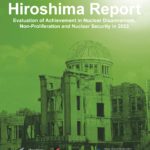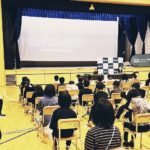3 Resumption of School Education and Support from the Local Community
While Honkawa National school was used as a first aid station for the injured soon after the atomic bomb was dropped, a special meeting for school principals took place on the 21st of August, 1945, to discuss the resumption of education 32). The meeting concluded that the children of Honkawa National School would study temporarily at Koi National School (approximately 2.5 kilometers from Honkawa National School) 33). Later, with the cooperation of local volunteers, on the 23rd of February, 1946, Honkawa School District and Hirosei School District were merged, and classes commenced in Honkawa National School. Back then, there were four faculty members, and the number of students was near 60 34). In addition, on March 10th, Kanzaki School District was also added to Honkawa 35). On April 8th of the same year, the first day of the semester, the reopening commenced with 196 students from seven classes and seven faculty members.
In Hiroshima City, from March, 1946, the construction of “barracks” -style school buildings began. However, amidst a scarcity of materials and financial difficulties, the speed of reconstruction and expansion did not keep pace with the increasing number of students. Because of this, some schools divided their students into two cohorts, one studying in the morning and the other in the afternoon, and some schools conducted classes in rooms where the students were packed in like sardines 36). Furthermore, there were few textbooks or writing supplies, so there was no question of conducting normal lessons 37). At Honkawa National School, due to delays in the reconstruction of the school building, which had been entirely destroyed by the atomic bomb, there were no facilities, forcing children to endure cold and inconvenience 38). Potato planting was implemented alongside lessons due to the shortage of food 39).
In these circumstances, parents and locals devoted themselves to the reconstruction of school education. At Honkawa National School, on May 26th, 1946, a small sports festival was conducted, organized by the district’s neighborhood association. Then, on May 29th, an education support association was formed. The purpose of the association was to improve the reconstruction of the school building, as well as raise money 40). Furthermore, on July 7th, a parents’ association was established, collecting three yen per student as a membership fee (half price for siblings). Years later, this association turned into the “Love of Education Association” (later, the PTA). The first chairperson was elected on July 30th 41). In this way, institutions supporting education, run by parents and the local community, began to take shape. As these institutions were forming, a joint memorial service was conducted at Sorasaya Charnel House on August 6th, the first anniversary of the atomic bombing.
Support from parents and the local community was the driving force behind the school reconstruction movement. Namely, they collected donations and raised funds for school reconstruction 42). With such efforts from parents and the local community, floors, windows and walls were built; the roof was waterproofed; classrooms were repainted 43). A support movement also began among foreigners. For example, on January 13th, 1947, Dr. Howard M. Bell, from the Civil Information and Education Section, GHQ, inspected Honkawa National School, together with Takizou Matsumoto, a member of the Lower House of the Diet. The purpose of the inspection was to collect information about the scarcity of school supplies and to undertake a study for the creation of a curriculum of social studies 44). However, Dr. Bell was shocked by the terrible condition of the children, studying in a steel-framed school building, shivering in cold winds. He returned to the school on January 18th, 5 days after his first visit. Observing, “I feel pity for the students. Without proper facilities, there can be no proper education. Please rebuild quickly so that the children can be protected from the cold wind,” Bell donated 2,500 yen from his own pocket, and gave 20 dozen pencils and 6 dozen colored pencils. Upon leaving Hiroshima, he said, “Don’t let anyone know about the donation until this place has been rebuilt” 45).
By this time, signs of reconstruction began to be visible. For example, on January 11th, 1947, a new principal was named, taking over for the previous principal who had been killed during the bombing. Also, on March 22nd, school meals began to be served again, albeit composed only of milk and side dishes 46)47).
32)Honkawa Elementary School (1948), “Enkaku Youkou” (Summary of School History), In Enkakushi (Magazine of School History), Honkawa Elementary School
33)Honkawachiku Hibaku no Gaiyou (Outline of A-bomb Damage in Honkawa District), p101
34)Hiroshima City (Ed.)(1957), In Hiroshima Genbaku Sensaishi Dai Yonkan Dainihen Kakusetsu, (Record of the Hiroshima A-bomb War Disaster Vol.4 Second edition), p.57
35)Honkawa Elementary School (1973), “Honkawakokumingakko Gakujihoukoku” (Report of School Events at Honkawa National School), Souritsu Hyakushunen Kinenshi (Memorial Magazine of 100th Anniversary of Establishment), Hiroshima Elementary School Executive Committee of 100th Anniversary of Establishment), p.144
36)Hiroshima City Board of Education (1981), “Gakkoukyouiku no Shinten” (Development of School Education), Hiroshimashi Kyouikuiinkai 30 nen no ayumi (30 Year-Hisotry of Hiroshima City Board of Education), Hiroshima City Board of Education,p.7
37)Hiroshima Genbaku Sensaishi Dai Yonkan Dainihen Kakusetsu, (Record of the Hiroshima A-bomb War Disaster Vol.4 Second edition), pp7
38)Honkawa Elementary School (1973), p.145
39)Honkawa Elementary School (1948)
40)Honkawa Elementary School (1973), p.145
41)Honkawa Elementary School (1948)
42)Honkawa Elementary School (1973), p.145
43)Ibid., p.145
44)Toshikuni Nakagawa (2015), “Howard Bell to Hiroshima no Jidoubunka: Senryougun to Jidoubunka Fukko ni Hiroshima no Miraiwo Takushita Hitobito” (Bell Howard and Child Culture in Hiroshima: People Entrusted Occupation Army and Child Culture Reconstruction with Future of Hiroshima), Hiroshima Municipal Archives Hiroshima Municipal Archives Bulletin: Online Special Edition,p.2
45)Ibid. p.2
46)Hiroshima City Board of Education (1981), p.161
47)Honkawa Elementary School (1948)








